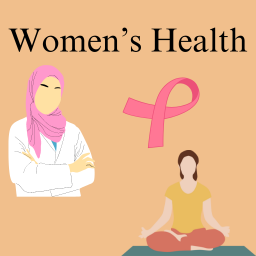Women's Health and Nursing Care

What is Women's Health
"Women's health" is a phrase that has come to signal movement away from a focus on gynecology synonymous historically with reproductive matters to gynecology, meaning that overall well being is shaped by the fit between the woman and her environment.
This expanded biopsychosocial
perspective is not just concerned with women's diseases, but their diseases,
too, and coincides with nursing's longstanding emphasis on the interface
between and among genetic, physiologic, psychosocial, economic, cultural, generational,
developmental, and lifestyle factors in determining health .
Research on Women's Health
Women's health research began as a critique of existing practices and their effects on women's well being.
In 1985, the Public Health Service Task Force on Women's Health Issues examined the role of the Department of Health and Human Services in addressing women's health and found that women were often not included as subjects in health research.
Women had historically been excluded from the first two stages of drug testing. Even female animals had typically not been used in constructing animal models because of “their hormonal fluctuations.”
The health problems that women suffered from
disproportionately were also not much studied, for example osteoporosis, breast
and ovarian cancer, urinary incontinence, the autoimmune diseases, violence,
and poverty.
Women's Health and Male Behavior
Health had been constructed so that male behavior was regarded as normative, and research conducted exclusively on males was typically generalized to all human beings. When women did not fare as well with the same treatment, they were regarded as atypical.
From Freud to Kohlberg, theoretical
models had been constructed so that women were regarded as less developed when
they did not act in a fashion similar to men, even when studied, the sociocultural
factors shaping health problems in girls and women were ignored, for example,
the relationship between learned helplessness and some kinds of depression, and
between anorexia and the popular acceptance that you can never be too rich nor
too thin.
Role of Social Health Systems
Social/health systems also had been prejudicial in important respects. Insurance policies did not necessarily cover health matters unique to women, for example, breast prostheses post mastectomy.
Women were not in
research and policy making positions proportionate to their numbers,
responsibilities, and educational preparation. The burden of family caregiving
that women largely bear remained invisible, notably in estimates of the Gross
National Product (GNP).
The Office of Research on Women's Health (ORWH) was established in 1990 within the Office of the Director of the National Institutes of Health (NIH) to address these lacunae.
A decade later, not coincidentally, the
majority of human subjects enrolled in all extramural NIH research were women,
and they were represented in Phase III clinical trials.
Nursing Research on Women Health
Often led by nurses, women's health research has become relatively mainstream in the ensuing years. SK Donaldson (2000). analyzed the achievements of nursing research between 1960 and 1999, and found substantial strengths in the area of women's health. #
The Center for Women's Health Research at the University of Washington, supported by the National Institute of Nursing Research (NINR), has increased understanding of menstrual cycle change, including the menopausal transition (Mitchell, Woods, & Mariella, 2002).
That Center has also played a role in translational research, for example,
offering a video presentation to help women in deciding if hormone replacement
therapy (HRT) is appropriate for them (Woods, 2002).
Concerns of Centers of Geriatric Nursing
One area of common concern to the five Centers of Geriatric Nursing Excellence funded by the Hartford Foundation is the experience of family caregivers, largely women (Archbold & Stewart, 1996).
Nurses have also brought new understandings to other developmental transitions, for example, the experience of women as mothers/ grandmothers (McBride & Shore, 2001), and how puberty may differentially affect girls in comparison to their male counterparts (Austin, Dunn, & Huster, 2000).
The ORWH has collaborated with
various NIH institutes to fund Specialized Centers of Research of Sex and
Gender Factors Affecting Women's Health. The one based at the University of
Michigan is conducting research on the pelvic floor, and nurses have pioneered
therapeutic use of pelvic floor muscle training in women (Miller, JM, 2002).
Health Behaviors and Women Health
Because one of its fundamental beliefs is the need to proceed from an understanding of the person environment fit, nursing has long been concerned about the importance of context in understanding health behavior.
Nurse midwives, for example, tend not to talk about “delivering the baby,” preferring instead to focus on the mother and how she would prefer her labor and delivery to go. Nurses were among the first to question a preference for the so called objective view of the researcher, historically male, over the subjective view of the patient (McBride & McBride, 1981).
They took the lead in using the diary/health journal as a way to analyze the complexity of women's reality. The research that has resulted has been informed by how women describe their lived experience.
A feminist ethic has emerged that is neither focused on “doing
good” nor “doing unto others what one would wish for oneself” but with
providing care that builds on the patient's perceptions of what is good for
her.
ORWH Agenda on Women Health
The ORWH has developed an Agenda for Research on Women's Health for the 21st century (Pinn, 2001). Many of its priorities dovetail with the focus of nursing research; for example, interdisciplinary approaches to chronic multisystem diseases with multifactorial etiology, caregiving, and health-related quality-of-life issues.
Indeed, most of the research centers
supported by the NINR focus on either healthy living and the prevention of
chronic disorders or quality of life in chronic illness. Developing effective
ways to manage chronicity, as opposed to serial management of a number of
diseases, is of particular concern to nurse researchers.
Nursing Research and Women Health
Women's health research has made major strides in the inclusion of females as research subjects, but the next challenge is to cease treating women as a monolithic group. Women vary significantly according to their circumstances.
Thus, it is important that research not just include girls and women, but over select for heretofore understudied populations, for example, diverse cultures, women of color, the elderly, rural and inner city women, the poor, lesbians, and women with disabilities.
The resulting findings are likely
to fuel the burgeoning movement towards an emphasis on the design of tailored
interventions.
In an attempt to reject “biology as destiny,” women's health research may also have inadvertently minimized the physiologic pathways involved in responses to stressful psychosocial conditions.
Future research
must, therefore, be concerned with women's experiences that exist on the
interface between the behavioral and the biomedical sciences in order to
provide additional insights into sex versus gender differences.




Give your opinion if have any.